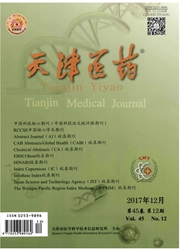

 中文摘要:
中文摘要:
目的:探讨低浓度利多卡因对慢性背根节压迫(CCD)模型大鼠背根节(DRG)神经元诱发簇放电(EB)的影响及电流机制。方法24只SD大鼠分为正常对照组和CCD组,每组12只。CCD组用小钢柱在左侧腰4、5背根节行慢性压迫,正常对照组未做任何处理。应用在体细胞内技术记录2组大鼠EB放电的发生率及利多卡因对阈下膜电位振荡的影响,用离体全细胞膜片钳技术记录不同浓度利多卡因对持续性钠电流(INaP)的影响。结果 CCD组EB发生率增高,达45.97%(57/124),和正常对照组相比差异有统计学意义(χ^2=26.810, P〈0.01);DRG局部给予低浓度(50μmol/L)利多卡因抑制INaP,致阈下膜电位振荡幅度抑制,进而影响EB发生。结论低浓度利多卡因通过阻断INaP抑制EB放电而发挥外周镇痛作用。
 英文摘要:
英文摘要:
Objective To study the effects and current mechanism of low concentration of lidocaine on evoked-bursting (EB) firing of dorsal root ganglion (DRG) neurons in rat model of chronic compression (CCD) of DRG . Methods Twenty-four SD rats were divided into normal control group (n=12) and CCD model group (n=12). CCD group was treated with chronic oppression on L4 and L5 DRG with L shape bar. Normal control group received no treatment. In vivo intracellular recording was used to record the incidence of EB and the effect of lidocaine on subthreshold membrane potential oscillation (SMPO). Patch clamp recording was used to record the effect of lidocaine on persistent sodium current (INaP). Results The incidence of EB increased in CCD group( 45.97%, 57/124), which was significantly different when compared with normal group (χ^2=26.810, P〈0.01). The magnitude of SMPO, INaP and EB were inhibited in a reversible way by lidocaine (50μmol/L). Conclusion The low concentration of lidocaine might play an analgesic effect in peripheral nervous system by se?lectively inhibiting INap, which participates in SMPO formation.
 同期刊论文项目
同期刊论文项目
 同项目期刊论文
同项目期刊论文
 期刊信息
期刊信息
